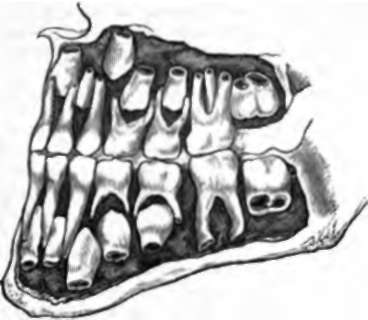56. The Milk Teeth
Description
This section is from the book "Animal Physiology: The Structure And Functions Of The Human Body", by John Cleland. Also available from Amazon: Animal Physiology, the Structure and Functions of the Human Body.
56. The Milk Teeth
The Milk Teeth are twenty in number, namely, two incisors, a canine or eye tooth, and two molars, on each side in the upper and the lower jaw. The permanent teeth are thirty-two in number, namely:—incisors and canines, replacing the corresponding milk teeth; premolars or bicuspids, replacing the milk-molars; and three true molar teeth on each side in each jaw, which are not preceded by any deciduous or milk teeth.

Fig. 48. Temporary and Permanent Teeth in the jaws of a child six years old. The temporary teeth are all still present, and the crowns of the corresponding permanent teeth are formed; the first molars have appeared, and behind them are the second molars with the divisions between the fangs in process of formation.
The incisor and canine teeth are simple, each having only one fang and one prominence of the crown; the crowns of the incisors being chisel-shaped, while those of the canines come to a point or cusp. The premolar teeth get the name of bicuspid because the crown of each has two cusps, an inner and an outer; their fangs likewise, especially those of the anterior premolars, have a tendency to divide towards the extremity. The molar teeth, both milk-molars and true, have the extremity of the crown thrown into several elevations, and are said to be multicuspid. Those of the upper jaw have three fangs, two on the outside, and one directed inwards. Those of the lower jaw have only two fangs, one in front of the other, but they are double fangs, that is to say, they are flattened as if composed of two combined, and have each two openings at the extremity.
57. In infancy the teeth begin to cut the gums about the seventh month, the central incisors appearing first, and the others in order backwards, with the exception that the first milk-molar precedes the eye-tooth in front of it. The last of this series, the second milk-molars, appear about the end of the second year. The next teeth to appear are the first true molars, sometimes called the five-year old teeth; then, about the seventh year, the milk teeth begin to drop by absorption of the fangs, and the permanent teeth to come up above the gums in their place. The changing of the teeth begins in front, and goes regularly backwards, with the exception that, as in the first dentition, the canines are delayed, both bicuspids making their appearance before the permanent canines come up, about the twelfth year. Soon afterwards, the second molars cut the gums, and lastly, at very variable periods, often a number of years later, the third molars, or wisdom teeth, come to the surface.
Continue to:
